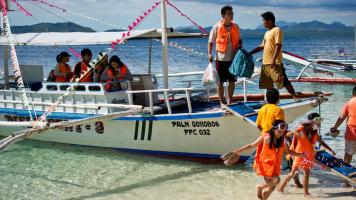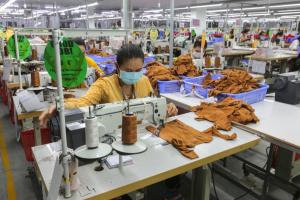
An estimated 85% of tourists in Coron and El Nido engage in snorkeling and diving to explore coral reefs. Photo credit: ADB.
The islands need to determine their capacity limits for tourism to reduce pressure on marine ecosystems.
Coron and El Nido in Palawan are said to be Alex Garland’s inspiration for the book-turned-movie, “The Beach.” The author and filmmaker reportedly set the location for his novel in Thailand because he wanted to keep these islands in the Philippines a secret from tourists.
Twenty-two years after the movie came out, however, the secret is out.
Coron and El Nido are now top destinations for marine-based ecotourism in the country. From just 76,815 tourist arrivals in 2008, tourism surged by 25% per year to 903,166 by 2019, according to data from the Asian Development Bank (ADB). By 2019, tourists stayed an average of 4–5 days, spent around $424.5 million, and supported 1,904 mostly small-scale enterprises employing 8,588 people—about 38% of the total workforce.
The rapid increase in tourism was driven by the strong interest in blue ocean ecotourism complemented by improved air, sea, and road accessibility, and enhanced destination marketing and investment in accommodations and related facilities and services.
Tourists typically enjoy island hopping and related activities, such as snorkeling, diving, swimming, and sight-seeing. An estimated 85% of tourists engage in snorkeling and diving to explore coral reefs, and in the case of Coron, to view its shipwrecks.
Balancing development and conservation
But there is a downside to the islands’ popularity, an ADB report said. While the coastal and island marine environment is “still relatively pristine,” a survey of 24 selected coral reef tourism sites shows some damage due to tourism. These include damage from boat groundings and boat anchors in both coral reefs and seagrass beds; damage from snorkelers and divers trampling on corals; siltation from land conversion and deterioration of water quality due to untreated effluents; pollution from improper site toilet and waste management facilities in beach areas; and use-conflict between fishermen and gleaners of reefs near resorts and marine protected areas.
Coron and El Nido are located in the northern part of the island Province of Palawan in the Philippines, which is situated within the Coral Triangle, the network of coral reefs considered as the global center of tropical marine biodiversity. The islands’ marine environment supports one of the richest fisheries in the country. Extensive areas of El Nido have been designated as part of a protected area. Palawan is part of the BIMP-EAGA subregion.
The COVID-19 pandemic reduced the number of visitors in 2020 by over 85%, giving the ocean ecosystems time to rest. However, it is likely that the 2019 tourist volume will be recovered in a few years, the report said. The potential for further tourism growth is high because of plans to improve air, sea, and road transportation.
But if the development of tourism continues in an uncontrolled and unsustainable way, growth could weaken if Coron and El Nido’s reputation as attractive destinations declines. If this happens, the report said tourist volumes may not increase significantly over 2018 levels in coming years.
The report said it is important to determine the islands’ “carrying capacity” to ensure that tourism growth is environmentally sustainable.
What is environmental carrying capacity?
The United Nations World Tourism Organization (UNWTO) defines environmental carrying capacity as ‘‘the maximum number of persons which could visit a location within a given period, such that local environmental, physical, economic, and socio-cultural characteristics are not compromised, and without reducing tourist satisfaction.’’
This definition indicates that various capacities—physical, economic, perceptual, social, ecological, and political—determine the maximum number of tourists. It requires a combination of science-based assessments at specific sites, an understanding of the current impact on the biophysical environment, and agreement among stakeholders on capacity limits and when to apply them.
The report notes that “both Coron and El Nido municipalities see themselves as prime tourist destinations in the Philippines that adhere to the principles of sustainable development.” Upholding these principles calls for a more managed tourism growth scenario that places a premium on protecting blue ocean resources, quality services, length of stay, and higher spending per day over just tourism volumes.”
The report said measuring a destination’s carrying capacity does not necessarily have to lead to a threshold. “An upper and a lower limit of tourism carrying capacity may be of more use than a fixed value,” it said.
The UNWTO definition recognizes that the maximum number of visitors per unit of time at a destination or site may vary depending upon the technology and management systems employed, and the extent to which stakeholders concerned are willing to trade off some ecosystem services (e.g., habitat for species, carbon sequestration) for tourism and recreation. The ability to measure the impact of these decisions and to take remedial actions to prevent further decline of ecosystem service values and enhance them is key.
This article was first published by BIMP-EAGA on 26 September 2022.

BIMP-EAGA
The Brunei Darussalam–Indonesia–Malaysia–Philippines East ASEAN Growth Area, or BIMP-EAGA, is a cooperation initiative established in 1994 to spur development in remote and less developed areas in the four participating Southeast Asian countries.


